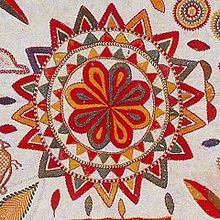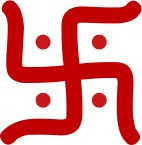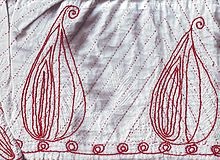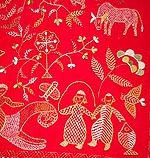[Author is Shri. Santanu Guha Thakurtha of Prayaash Design Studio and this article appeared in one of the issues of Silk Mark Vogue magazine ]
Etymologically the word “Kantha” originally suggests a light quilt of mild winters and cool monsoon nights. Though the concept exists in almost all parts of the world, the form of quilting that prevails in Bengal is unique and not only serves as a functional article but also represents the cultural identity and folk art of this land. It is essentially a women’s art since the development of kantha art emerged out of the creative expressions of rural women as gifts for loved ones. Several layers of used or worn out materials such as saris, lungis and dhotis are stitched together to make a single kantha. The colourful patterns and designs that are embroidered on these articles resulted in the name “Nakshi Kantha”- derived from the word “naksha” which refers to artistic patterns. Each of these kanthas represents the contents of a woman’s mind and is filled with romance, sentiment and philosophy. 500 years ago, earliest reference of Kantha is found in ‘Sri Chaitanya charitamrita’ by Krishandas Kabiraj.
The Kantha Tradition
Like any other folk art kantha making is influenced by the factors like availability of materials, daily needs, climate, geography, economic factors etc. Probably the earliest form of kantha was the patch work kantha and the kanthas of decorative appliqué type evolved from this concept.
400 years ago, Portuguese arrived on the eastern coast of India and was impressed by the Kantha quilts, which reminded them of their needle-crafts, back home 17th century Portuguese ship “71 or-de-la-Mar” carried Bengal Kantha to Portugal. Kantha stitched works exported from Bengal early 17th century and were worn by the Queens of Portugal. The traditional designs had a central motif, such as ‘Satadal Padma’ hundred petal lotus or a large spiral of energy. Trees of life would be placed in four corners with free flowing jaals.
Influence of Religion and Folk Belief
Hindu women during 19th century used human and animal forms to tell stories of Gods and Goddesses and their Vahanas. Bengali women were free to draw upon their rich indigenous surroundings as well as their contemporary stories. To them the fabric was the artist and the person was the artisan. Mid 19th century, colour schemes and designs of Nakshi Kantha began to change to make them suitable for use on modern garments. 1930 Kabiguru Rabindra Nath Tagore and his daughter-in-law Pratima Devi trained Santali women in Birbhum District and quality work was produced under the tutelage of ‘Kalabhaban’ Artists.
Kantha comprises of the simplest stitch in the language of embroidery – the running stitch, yet it is making a mark in the National as well as International Market. Today ‘Nakshi Kantha’ is treated as traditional form of folk art as well as catering to top designers for their haute-couture creations. Nakshi Kantha in Bangladesh – Jessore, Faridpur, Mymensingh and Jamalpur have similar styles when it comes to stitching. These precious works of art remain silent witnesses of past, present and future of Bangladesh.
Kantha in art & culture
The ‘Paisly’ or ‘Kalka’ plays a significant role in Indian art and hence it is used not only on Kanthas but forms the design on other fabric as well. Each Kantha is designed by woman who embroiders it and she determines the pattern guided purely by intuition in the selection of figural and ornamental motifs, in their arrangements as well as choice of colours. Kantha embroidery is the prerogative of Bengali woman and is practiced by all sections of Rural Bengal. Kantha work is being revived and given modern touches by the designers. Nakshi Kantha has been a steady, thriving business for centuries in Bengal. Its revival is based on the art and crafts trends, with high International demand for genuine hand crafted work. The effect is very pleasing to the discerning eyes and the price is very reasonable for the effort that goes into the creation of each unique piece. Modern opulence, an easy elegance, a sense of grace and an instinct for the fine things in life……a love of luxury and a taste for redefined style, all together translate beautifully into the fashion trend now.
Kantha sarees
Nakshi Kantha nowadays is done on saris – (where fabrics are mainly Tussar, Silk-Bishnupuri and South cotton), Bedcovers with pillow, Cushion covers, Salwaar sets, Kurtis, Dupattas, Stoles, Running materials, Blouse pieces, Scarves, Purses, Mobile covers, wall hangings and many more. It seems to be one of the highest shareholders in the field of production of hand crafted Textiles. India carries varied culture and heritage. Nakshi Kantha is one of the top levels amongst them. Some of the most common motifs used are: lotus, solar, moon, chakra or wheel, swastika, tree-of-life, kalka, water, mountain, fish, boat, agricultural items and animals (elephant, horses, peacocks, tiger, monkeys, etc). While each kantha has designs that are unique to its maker’s imagination, usually there is a basic traditional pattern. Chok Par: eye border, Barfi Par: diamond border, Beki Par: wavy or bent , Nolok Taga: nose ring border, Maach Par: fish border, Chok Taga: eye motif border, Dheu Par: wavy border, Gaach Par: tree border.
Nakshi Kantha – hand stitching is concentrated among Bengal villages. The karigars stay in remote villages in and around Bolpur, like Illambazar, Nanur, Kirnahaar, Debogram and Sriniketan place of Kantha. The designs are drawn on the products, the colour scheme is decided accordingly and then the karigars start working on that with the decided coloured threads. A fully hand stitched 6.5 mts sari takes almost seven months time to get ready for marketing.
Types of Kanthas
Niaz Zaman in her book ‘The Art of Kantha Embroidery’ classified the kanthas in following categories according to the stitch employed:
Running Stitch kantha: Running stitch kantha is truly the indigenous kantha. They are subdivided into Nakshi or figured and par tola or patterned. Nakshi or figured kanthas are again divided into motif kantha or scenic ones.
Lohori Kantha: The name derived from Persian word ‘lehr’ meaning ‘wave’. This kantha is particularly popular in Rajshahi. These kanthas are further divided into soja (straight or simple) kantha, Kautar khupi (pegion coop or triangle), borfi or diamond (charchala, atchala or barachala etc).
Lik or Anarasi (pineapple) Kantha: Found in Chapainawabgonj and Jessore area. The variations are lik tan, lik tile, lik jhumka, lik lohori.
Cross Stitch or Carpet Kantha: This kantha was introduced by the English during the British Rule in India. The stitch employed in these kanthas are cross stitch.
Sujni Kantha: This kantha is found only in Rajshahi area. The popular motif used is undulating floral and vine motif.
Supporting a great cause
Nakshi Kanta is women oriented avocation, through which the village people gain a supplementary income to support their family, contribute to their children’s education and the family to become financially independent. Individual development leads to the social development of that place. Small co-operative societies are formed to support the karigars and they take the finished products for marketing. Self-help groups, Bank and financial Institutions extend easy term loans to the karigars enabling them to create their innovative work smoothly. A multi crore annual turnover comes from this rich and beautiful art. Let’s salute the Royal heritage of Rural Bengal and extend all out co-operation to keep this masterly craft vibrant.





I like the helpful information you provide in your articles.
I’ll bookmark your weblog and check again here frequently.
I am quite certain I will learn a lot of new stuff right here!
Best of luck for the next!
my blog search engine optimization
i would like to work on nakshi kantha , in an project , to uplift its present status so i want to know some groups or organisation’s name, adress working on nakshi kantha.. thank u
Your article most informative. Please let me know the suppliers of Patachitra paintings on silk fabric from Orissa. Thanks.